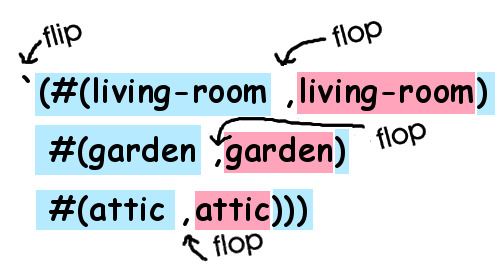Locations
In this simple game, there will only be three different locations: A house with a living room and an attic, along with a garden. Here is a picture of what our world looks like:

We're going to provide descriptions for each of these locations, as well as provide metadata associated with them. We'll do that later with something called records. But for now, just to get some practice with some of the basic concepts in Lisp, let's define three variables, each containing bogus data for our locations:
lfe> (set living-room "Super-cool data.")
lfe> (set garden "Even cooler data.")
lfe> (set attic "The best data evar.")
Now, assume we wanted to bring all of these together in yet another, mind-blowingly cool variable, state:
lfe> (set state `(#(living-room ,living-room)
#(garden ,garden)
#(attic ,attic)))
What's going on here? Well, we've defined what is called a "property list" in LFE, a list of key/value tuples. Our three keys are the atoms living-room, garden, and attic. Our three values are the data stored in each of the variables.
But there's more going on there, and it looks pretty strange: that's back-quoting and unquoting you're seeing. Just like above, when we used a quote to flip the compiler from Code Mode to Data Mode, by using the back-quote (the quote in the upper left corner of the keyboard) we can not only flip, but then also flop back into Code Mode by using a comma:

This "back-quoting" technique is a great feature in Lisp -- it lets us write code that looks just like the data it creates. This happens frequently with code written in a functional style: By building functions that look like the data they create, we can make our code easier to understand and also build for longevity: As long as the data doesn't change, the functions will probably not need to be refactored or otherwise changed, since they mirror the data so closely. Imagine how you'd write a function like this in VB or C: you would probably chop the path into pieces, then append the text snippets and the pieces together again -- a more haphazard process that "looks" totally different from the data that is created and probably less likely to have longevity.